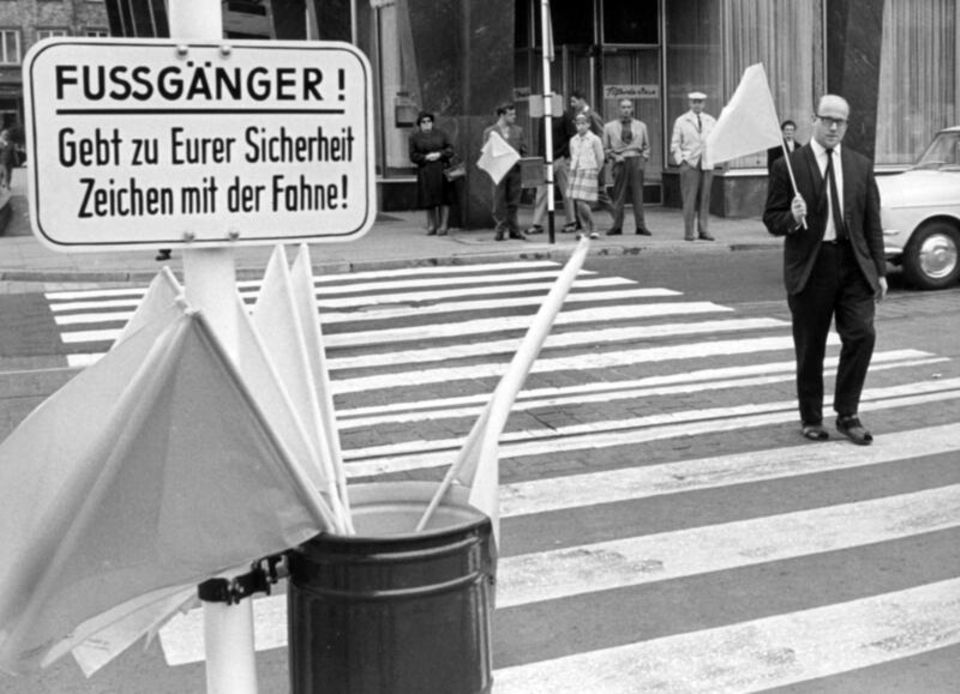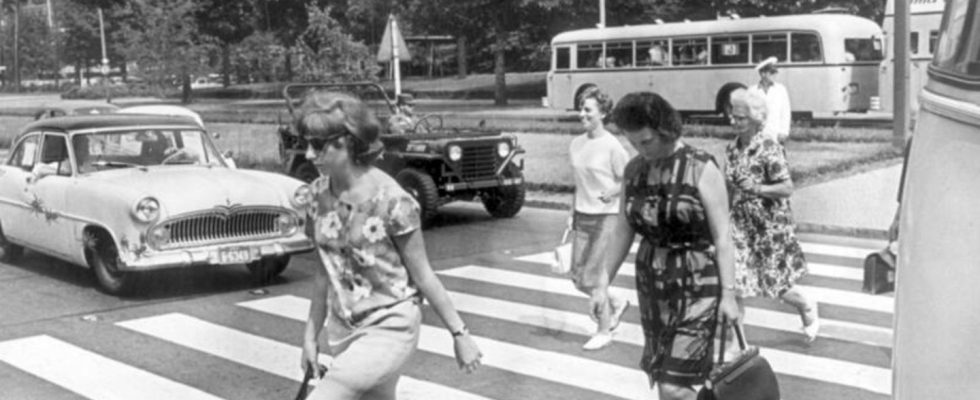70 years of zebra crossings
What the Beatles, Monty Python and the hoofed animal have to do with the pedestrian crossing
A zebra crossing in Berlin in 1964.
© Konrad Giehr/dpa
They bring pedestrians safely through traffic – and have been doing so for 70 years. Here you can find out what the Beatles, Monty Python and the hoofed animal have to do with zebra crossings.
As a rule, they are at least three meters long, 50 centimeters wide and painted on the road at intervals of 50 centimetres. We’re talking about the zebra crossing. At more than 600 places in Germany, the white bars should get people safely across the street. On Thursday (24 August) 70 years ago, the Pedestrian crossing in the road traffic regulations (StVO) of the Federal Republic.
From mammal to acronym
White stripes on a black background – just like a zebra. That’s the most obvious answer as to where the pedestrian crossing got its name from. But it can also be more complicated, for example with a clearly defined acronym.
According to the Society for German Language, the letters in “zebra” can also stand for “signs of a particularly considerate driver”. Admittedly, the somewhat intentional dissolution of the term was intended to motivate drivers to behave in an exemplary manner on the road.
Who is allowed to do what
With such statistics, the question quickly arises: How do I behave correctly at a zebra crossing? In principle, according to the StVO: Pedestrians, wheelchair users and users of e-mobiles for seniors have priority. Drivers of cars, motorbikes and cyclists are required to stop their vehicles if someone wants to cross the road. The only exception to this are rail vehicles. A tram may cross the zebra crossing at any time.
How about security?
For pedestrians, as always, it is better to be safe than sorry. Better not to walk across the street without looking left and right! After all, not everyone obeys the traffic rules. According to accident figures from the Federal Statistical Office, there were 3,745 accidents at zebra crossings in 2022, in which people were injured. 15 of them did not survive the accidents.
And since when do the crossings exist?
In Germany, zebra crossings were painted as early as 1952. The world’s first had already been in London four years earlier: in 1948 dashed lines were attached to crossings as a test. In 1949, the crossing appeared for the first time in an international road traffic agreement.

“Raise the flag” was the motto for the first time in 1964. Pedestrians should take a yellow flag out of the container before crossing the zebra crossing and wave it when crossing the road. On the other side, the flag is then put back into a second container.
© Heinz Ducklau/dpa
It has been in the German Road Traffic Regulations since 1953, but it was only eleven years later that pedestrians had priority. The traffic regulations of the GDR from 1964 stipulate that Vehicles on “pedestrian protection routes” have to give way.
Streaks in mushroom head fever
Great Britain has not only the first, but also the most famous crosswalk. A pedestrian crossing in London is a daily contact point for tourists, because the cover photo of the Beatles’ cult album of the same name was taken on Abbey Road.
Beatlemania
The 1964 breakthrough: The Beatles at the height of their fame in pictures
What many forget when posing on the iconic strip: that there is normal traffic at the photo location. Small traffic jams keep forming, and the Beatles fans only let themselves be swept away from the spell of John, Paul, George and Ringo by a concert of horns from impatient car and bus drivers.
“SillyWalk” in the Netherlands
But not only the Brits decorate zebra crossings with pop culture references. In Spijkenisse, the Netherlands, a sign asks passers-by to cross the street in Monty Python’s “Silly Walk”. The best way to do this is to throw your leg in the air or wave your arms wildly. The Norwegian Ørje is also adorned with a Monty Python-style transition, even if the associated road markings have now disappeared there.


